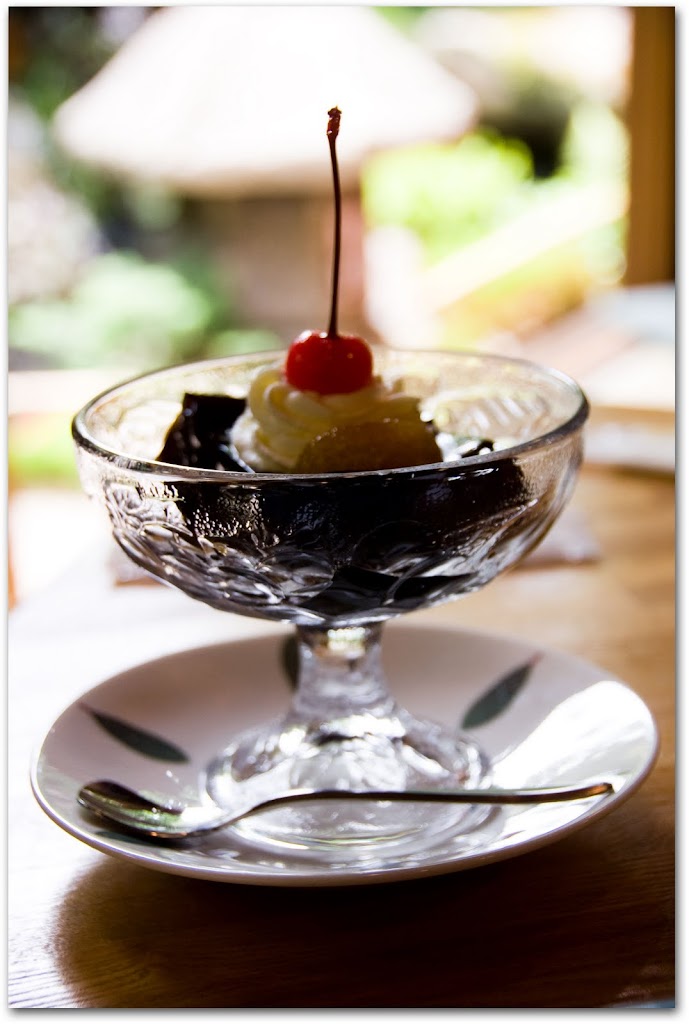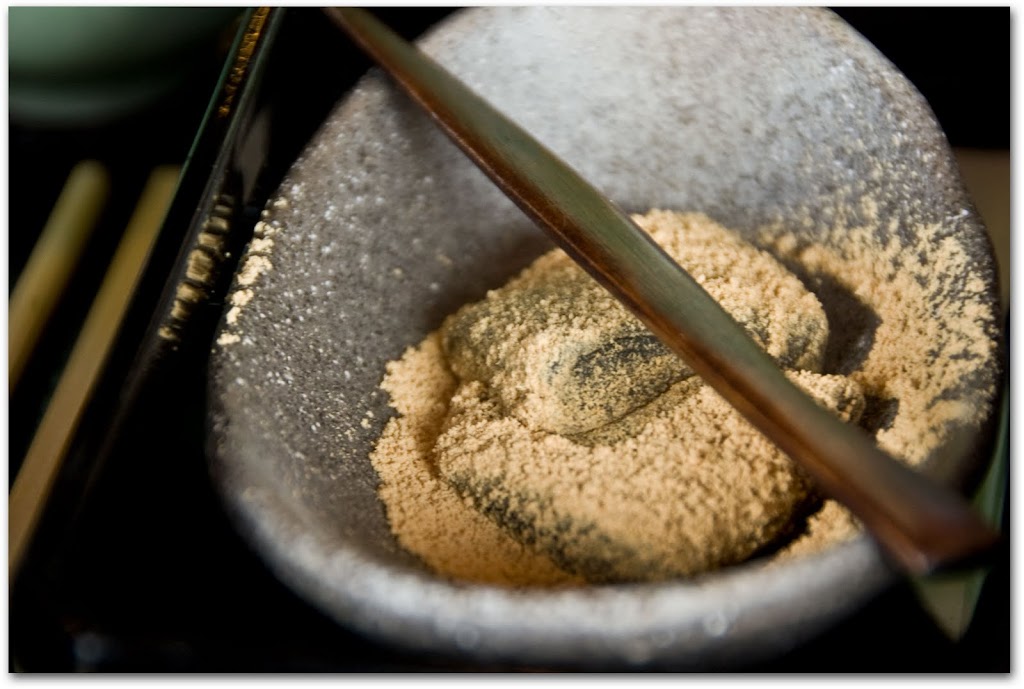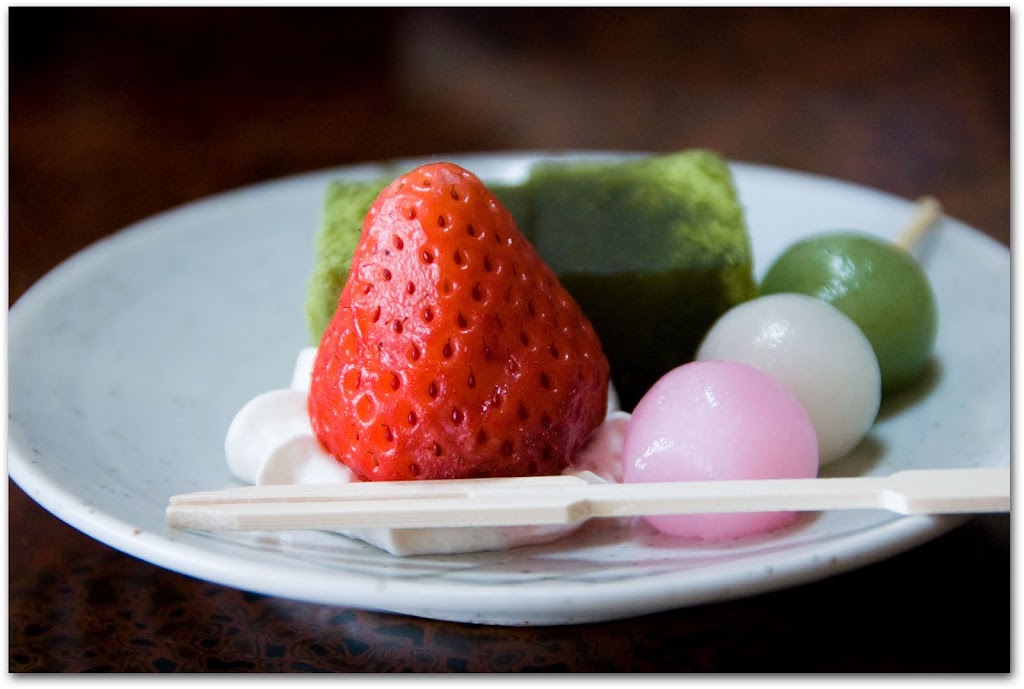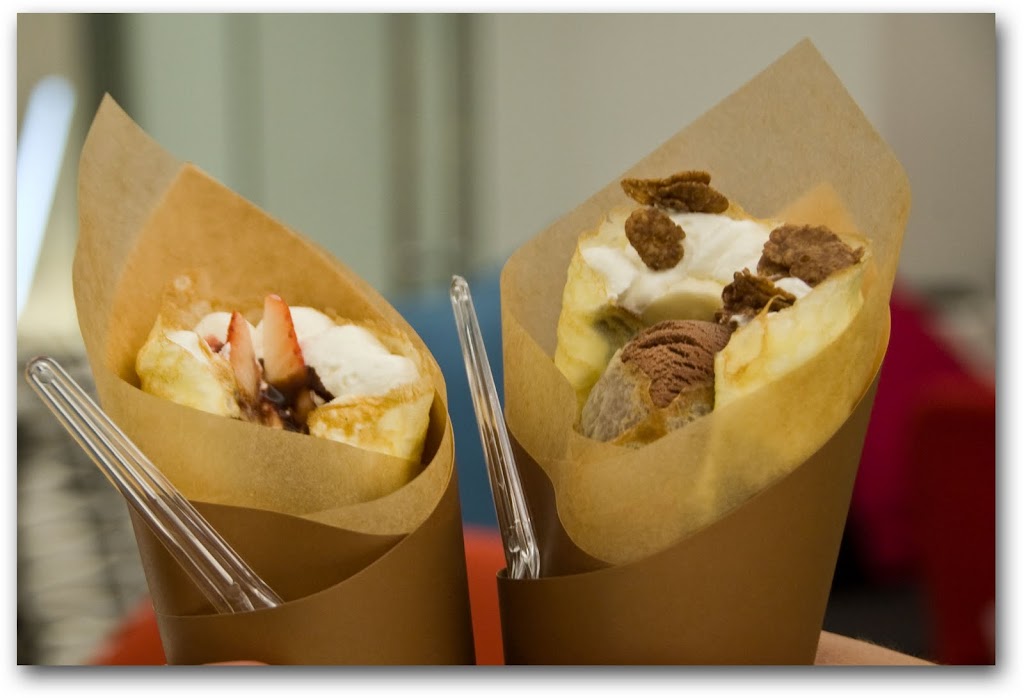Japanese food
Tuesday, November 29, 2011
japanese desserts-sweet and squishy!!
Gummy desserts
I 
Gummy candy
Gummy candy: Forget gummy bears; in Japan, there's gummy fish, flowers, fruit, and even gummy sushi that make the perfect gifts to take home . . . assuming you don't eat them on the way back to your hostel.
Coffee jelly: Expanding on the gelatin desserts, nearly every coffee shop in Japan sells coffee jelly which, as far as we can tell, is considered an acceptable substitute to drinking a cup of joe in the morning. In fact, because Japanese coffee tends to be fairly weak, coffee jelly packs a stronger punch for those early mornings.
Warabimochi
Warabimochi: Warabimochi is a cooling jelly-like dessert made from bracken starch and dipped in sweet, nutty kinako, a toasted soybean flour. A Kansai specialty, in Kyoto and Nara, this is the summertime dessert and in the hottest months, warabimochi trucks patrol the streets.
Warabimochi
Perhaps our favorite dessert in Japan, we can't wait to try making it at home using Clotilde's recipe at Chocolate & Zucchini.
Mochi
Mochi: The quintessential Japanese dessert, mochi is a round dumpling made from ground glutinous rice flour , often stuffed with jelly, jam, pastes, or ice cream. The most common filling is a slightly sweet red bean paste but we have seen exotic flavors like cherry blossom (sakura), mango, passion fruit, and others.
Dango
Dango: Dango are related to mochi in that both are made from glutinous rice flour. Dango, however, tend to be dense, sticky, and not stuffed with fillings. The version shown here is boccan dango, colored with red beans, eggs, and green tea.
Cookies with red bean filling
Cookies: When the Japanese travel, they shop for meibutso, a local food specialty, as a souvenir to take home. In Hiroshima and Miyajima, the Japanese opt for cookies shaped like maple leaves and stuffed with a thick red bean paste.
Maple cookie machine
Find a place that makes the cookies in huge conveyor belts and ask for yours to be served piping hot so the filling melts into the steaming cookie.
Japanese crepes
Crepes: Crepes in Japan are often folded in triangular cones to be eaten standing up and sold in stands facing the street. However, you will never see a Japanese person eating one while walking because eating and walking is considered rude.
Ice cream: Ice cream is a Western import that has invaded Japan. There are ice cream stores everywhere and most convenience stores have a huge display of ice cream bars to pick up and eat. We particularly liked the unappetizing looking but delicious tasting black sesame ice cream and the variety of Japanified flavors from Haagen Dazs like burnt sugar ice cream, green tea and cookies, and raspberry and cream cheese.
Kyoto Food Guide
As Japan's former capital and seat of the imperial court for over a thousand years, Kyoto offers a rich culinary tradition. The local food culture is diverse and ranges from aristocratic kaiseki ryori course dinners to the vegetarian shojin ryori of monks and the simple obanzai ryori home style cooking.
While some restaurants look to the past for inspiration, others experiment with new flavors. Fusion restaurants, that combine ingredients and techniques of Kyoto cuisine with cooking styles from other parts of the world, can also be found in the city. The Pontocho nightlife district is one of the best places to find good fusion restaurants alongside traditional establishments. Not far away, the Gion district also offers a wide range of interesting dining opportunities, as is the Kyoto Station area.
Regular Japanese food that is not necessarily associated with Kyoto in particular, such as ramen, sushi and udon, is also available across the city. Food fans should not miss a visit to the Nishiki Market in central Kyoto, which has been serving the city for many centuries.
Kaiseki ryori has its origin in the traditional tea ceremony, but later evolved into an elaborate dining style popular among aristocratic circles. Kyoto style kaiseki ryori (kyo kaiseki) is particularly refined, placing an emphasis on subtle flavors and local and seasonal ingredients. A kaiseki meal has a prescribed order of courses which is determined by the cooking method of each dish.
A common way for travelers to enjoy kaiseki is by staying at a ryokan where a kaiseki dinner is included with the stay. But kaiseki meals can also be enjoyed at restaurants, including high end ryotei, many of which can be found in the Pontocho and Gion districts of Kyoto. A good kaiseki meal usually costs around 10,000 yen per person, but prices can go as high as 30,000 yen or as low as 6000 yen. Some restaurants depart from tradition and include elements of foreign cuisines.
Whereas kaiseki developed out of the affluence of the aristocrats, shojin ryori developed from the austerity of Buddhist monks. Prohibited from taking the life of other living creatures, Buddhist monks had to make do without meat or fish in their diet. Consisting of strictly vegetarian dishes, shojin ryori can nonetheless be savory and filling. Travelers who spend the night at a temple lodging will be able to enjoy a meal as part of the stay.
A common ingredient in shojin ryori is tofu, which is a local specialty of Kyoto. The preparation of tofu is so common that it can also be referred to as Tofu Ryori ("tofu cuisine"). One popular dish that is widely served at restaurants is Yudofu, soft tofu simmered with vegetables in broth. A meal of Yudofu usually costs 1500 to 2000 yen, but the price can be higher or lower depending on the quality of the restaurant. The Nanzenji and Arashiyama districts are particularly famous for tofu cuisine.
Obanzai Ryori is the traditional home style cooking of Kyoto. It is made up of multiple small dishes that are usually quite simple to prepare. Local produce that is in season is best suited for the dishes. Although the cooking methods are usually not complicated, obanzai dishes can be made very rich by chefs skillfully bringing out the natural flavors of the ingredients.
Restaurants that serve obanzai ryori can be found all over Kyoto. Many of them have a relaxed and friendly atmosphere that reflects the home style of cooking. A full meal usually costs 2000 to 3000 yen, but can vary depending on the number and type of dishes ordered.
Ramen!!!

Ramen are very popular noodle dishes in Japan, and boiled noodles are basically served in different flavored soup with many toppings. Chukamen noodles which are generally made with wheat flour and kansui (alkaline solution) are used for ramen dishes. There are many regional speciality ramen available in Japan. They are different in broth, soup flavors, toppings, noodle texture, and more. Making a delicious ramen isn't easy if you are making the soup from scratch. The taste of ramen mainly depends on the soup, and it requires skills to make delicious soup. Ramen chefs usually train for a long time to make good ramen soup. Each ramen shop has its own way to make ramen soup, and there are so many different ways. Chicken bone, pork bone, dried sardines (niboshi), and/or kombu are used to make soup stock. Vegetables, such as ginger, negi onion, garlic, or/and mushrooms are also added. Categorized by soup flavors, there are mainly four kinds of ramen: shio ramen (salt flavored soup), shoyu ramen (soy sauce flavored soup), tonkotsu ramen (pork bone based creamy soup), miso ramen (miso flavored soup). Common ramen toppings are negi, shinachiku (seasoned bamboo shoots), nori (dried seaweed), boiled egg, narutomaki, and lots more.
Sushi
Sushi (すし、寿司, 鮨, 鮓, 寿斗, 寿し, 壽司) is a Japanese food consisting of cooked vinegared rice (shari) combined with other ingredients (neta). Neta and forms of sushi presentation vary, but the ingredient which all sushi have in common is shari. The most common neta is seafood.
Raw meat sliced and served by itself is sashimi.
The original type of sushi, known today as nare-zushi (馴れ寿司, 熟寿司), was first developed in Southeast Asia, and spread to south China before introduction to Japan.The term sushi comes from an archaic grammatical form no longer used in other contexts; literally, sushi means "sour-tasting", a reflection of its historic fermented roots.
|
Monday, November 28, 2011
Japanese Table Manners
Tables and sitting
In Japan, some restaurants and private homes have low tables and cushions on the floor, rather than Western style chairs and tables. These are usually found on tatami floors. Please visit our information page about sitting techniques and rules for more information.

A restaurant with traditional low tables Itadakimasu and Gochisosama
In Japan, you say "itadakimasu" ("I gratefully receive") before eating, and "gochisosama (deshita)" ("Thank you for the meal") after finishing the meal.
Individual versus shared dishes
It is not uncommon in private households and in certain restaurants (e.g. izakaya) to share several dishes of food at the table rather than serving each person an individual dish. When eating from shared dishes, move some food from the shared plates onto your own with the opposite end of your chopsticks or with serving chopsticks that may be provided for that purpose.
Chopsticks
The proper usage of chopsticks is the most fundamental element of Japanese table manners, and therefore, we have assigned them a separate information page.
Some Table Rules
When drinking alcoholic beverages, it is customary to serve each other, rather than pouring your own beverage. Periodically check your friends' cups and refill their drinks if their cups are getting empty. Likewise, if someone wants to serve you more alcohol, you should quickly empty your glass and hold it towards that person.
While it is considered bad manners to become obviously drunk in some formal restaurants, for example in restaurants that serve kaiseki ryori (Japanese haute cuisine), the same is not true for other types of restaurants such as izakaya, as long as you do not bother other guests.
Do not start drinking until everybody at the table is served and the glasses are raised for a drinking salute, which usually is "kampai". Avoid using "chin chin" when drinking a toast, since in Japanese this expression refers to the male genitals.
In Japan, some restaurants and private homes have low tables and cushions on the floor, rather than Western style chairs and tables. These are usually found on tatami floors. Please visit our information page about sitting techniques and rules for more information.
In Japan, you say "itadakimasu" ("I gratefully receive") before eating, and "gochisosama (deshita)" ("Thank you for the meal") after finishing the meal.
Individual versus shared dishes
It is not uncommon in private households and in certain restaurants (e.g. izakaya) to share several dishes of food at the table rather than serving each person an individual dish. When eating from shared dishes, move some food from the shared plates onto your own with the opposite end of your chopsticks or with serving chopsticks that may be provided for that purpose.
Chopsticks
The proper usage of chopsticks is the most fundamental element of Japanese table manners, and therefore, we have assigned them a separate information page.
Some Table Rules
- Blowing your nose in public, and especially at the table, is considered bad manners.
- It is considered good manners to empty your dishes to the last grain of rice.
- Talking about toilet related and similarly unappetizing topics during or before a meal is not appreciated by most people.
- Unlike in some other parts of East Asia, it is considered bad manner to burp.
- After eating, try to move all your dishes back to the same position they were at the start of the meal. This includes replacing the lids on dishes and putting your chopsticks on the chopstick holder or back into their paper slip.
When drinking alcoholic beverages, it is customary to serve each other, rather than pouring your own beverage. Periodically check your friends' cups and refill their drinks if their cups are getting empty. Likewise, if someone wants to serve you more alcohol, you should quickly empty your glass and hold it towards that person.
While it is considered bad manners to become obviously drunk in some formal restaurants, for example in restaurants that serve kaiseki ryori (Japanese haute cuisine), the same is not true for other types of restaurants such as izakaya, as long as you do not bother other guests.
Do not start drinking until everybody at the table is served and the glasses are raised for a drinking salute, which usually is "kampai". Avoid using "chin chin" when drinking a toast, since in Japanese this expression refers to the male genitals.
Okayu..yummy!!!
Do you like rice porridge? It's called okayu or kayu in Japan and is known as an easily digestible dish. I like simple okayu seasoned with salt, but you can make it more nutritious by cooking with chicken, vegetables, and so on, or adding lots of toppings. I sometimes make okayu for breakfast when I don't have much appetite in the hot weather. It's really easy on our stomachs.
Yield: 2 servings
Ingredients:
- 1/2 cup Japanese rice (short grain rice)
- 3 cups water (adjust the amount of water based on your preference)
- 1/2 tsp salt
- for toppings (optional):
- chopped green onion
- sesame seeds
- umeboshi (ume pickles)
Preparation:
Wash Japanese rice and drain. Put water and rice in a heavy bottomed pot or earthenware pot. Leave it for about 30 minutes. Cover the pot and put it on medium-high heat and bring to a boil. Turn down the heat to low and cook the rice for about 30 minutes. Stop the heat and let it steam for about 10 minutes. Season with salt. Serve into individual rice bowls. Put toppings, such as chopped green onion, sesame seeds, or/and umeboshi if you would like.
Japanese cuisine? What is it????
The modern term "Japanese cuisine" (nihon ryōri (日本料理) or washoku (和食)) means traditional-style Japanese food, similar to that already existing before the end of national seclusion in 1868. In a broader sense of the word, it could also include foods whose ingredients or cooking methods were subsequently introduced from abroad, but which have been developed by Japanese people who have made these methods their own. Japanese cuisine is known for its emphasis on seasonality of food (旬, shun),quality of ingredients and presentation. The Michelin Guide has awarded Japanese cities by far the most Michelin stars of any country in the world (for example, Tokyo alone has more Michelin stars than Paris, Hong Kong, New York, LA and London combined.
Introduction to Japanese Food
Rice is a staple of the Japanese diet. Rice cakes (mochi) are also commonly consumed. Japanese people even call each meal "gohan" which usually indicates steamed rice. For example, breakfast is called "asa-gohan". A bowl of steamed rice is included in typical Japanese meals. Side dishes are called okazu and are served with rice and soup.
Traditonal Japanese breakfast consists of steamed rice, miso (soy bean paste) soup, and side dishes, such as grilled fish, tamagoyaki (rolled omelet), pickles, nori (dried seaweed), natto, and so on. Various rice bowls and noodle dishes are popular for lunch. For example, ramen, soba, udon, gyudon beef bowls are popular. Many people take bento lunch boxes to school or work. Dinner is usually the main meal of the day. Modern Japanese dishes are highly influenced by other Asian and Western cuisines.
Japanese people distinguish traditional Japanese-style dishes as "wa-shoku" (wa means Japanese-style and shoku indicates food) as opposed to Western food, which is generally called "yo-shoku". Chinese dishes are called "chuuka", and chuuka dishes cooked in Japan are arranged in Japanese-style. It's similar to authentic Chinese dishes, but has its differences.
Besides rice, seafood is highly consumed in Japan since the country is surrounded by oceans. Seaweed, fish, clams, fish cakes are popular ingredients in Japanese cooking. Dashi soup stock used in traditional dishes is made from katsuobushi (dried bonito flakes) or/and kombu (kelp). Essential seasonings are soy sauce, mirin, miso, and so on.
Japan is a small country, but each region or even a city has own specials. Mainly, there are Kanto region (eastern area of the main island) food and Kansai region (western area of the main island) food. Generally, Kanto food has strong flavors, and Kansai food is lightly seasoned. Many dishes are cooked differently between Kansai region and Kanto region.
To eat Japanese-style meals, chopsticks are commonly used. Also, Japanese people use forks, knives, or spoons, depending on what types of food people are eating. Traditional Japanese table setting is to place a bowl of rice on your left and to place a bowl of miso soup on your right side on the table. Other dishes are set behind these bowls. Chopsticks are placed on a chopstick holder in front of rice and soup bowls.
Subscribe to:
Comments (Atom)












